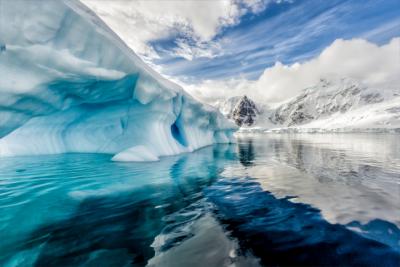Travel Offers
Travelmyne Featureprint
Distance
Antarctica - A journey into the Eternal Ice
Not long ago, a journey to the mysterious South Pole was considered impossible. Now many adventurers and discoverers want to get to know the most southern point on earth. The fascinating blue of the ice shelves and the gigantic colonies of Arctic penguins allure more and more tourists to the eternal ice every year.

Geography - Antarctica in the Southern Ocean
The Antarctica is the most southern continent on earth and measures 13,2 million km² in area. Together with the gigantic ice shelves and pack ice zones as well as the surrounding waters, the continent constitutes the Arctic region. The continent is enclosed by a number of seas such as the Weddel Sea, the Amundsen Sea and the Ross Sea. It can be divided into two parts: West and East Antarctica. The Transantarctic Mountains constitute the natural border between both parts. Besides the enormous glaciers, ice streams and the ice shelves, there are also large regions which are not covered in ice. These are called "Antarctic oases". Two examples are the Bunger Oasis and the Schirmacher Oasis. The weather in the Antarctica can only be classified as a climatic extreme. The average temperature is about -55 °C but it can get considerably colder. With these conditions, the Antarctica is the coldest continent on earth. However, the region still has two seasons - summer and winter. During the winter months from March to September the sun rarely shines and the polar night occurs. During the summer months it is bright almost all the time, which is called polar day.

Nature - Of ice deserts and emperor penguins
The Antarctic mainland is the world's greatest ice desert and accommodates a number of underground lakes. The coastal region is characterised by gigantic ice shelves. Although the areas of land change continuously, the biggest ice shelves were named. Examples are the Ross Ice Shelf and the Filchner-Ronne Ice Shelf. The table icebergs in the sea are also typical of the landscape. They float over the ocean with the current for thousands of kilometres, some of them even cover the enormous distance to the warmer Atlantic Ocean. The pack ice zone in front of the Antarctic mainland is one of the greatest ecosystems on earth. Whales, sea lions and different species of penguins such as the emperor penguin populate this region in great numbers. Seals and various types of birds like the snow petrel also live in the country of everlasting cold. In fact, several species of plants were discovered in the Antarctica's ice-free "oases". Apart from a number of lichens, two flowering plants were found - the so-called Antarctic hair grass and the pearlwort.

Culture - From admiral Byrd to modern tourism
The Antarctica does not really have culture. There is no indigenous population and even today it is mostly scientist who inhabitant the regions's polar stations. The discovery of the country, however, is of cultural value. Long before the actual development, geographers assumed that there must be a landmass in the most southern parts of the earth. First prove came from sailors and fishermen in the 1820s but decades passed before the ice land was conquered. In 1895 the International Geographic Union attended to the matter and send the first explorers searching for the South Pole. In the 20th century the continent was finally developed systematically. Air traffic technology made this possible. The greatest Antarctic Expedition of all time took place at the command of the US American admiral Richard Evelyn Byrd. His extraordinary and bizarre reports of his discoveries caused a sensation among the people who had stayed at home. In the 1990s the tourisms in the Antarctic started. Only 1000 travellers went on the exciting journey back then. Now interest is growing and over 40.000 tourists set out to explore the South Pole every year.

Experience - Icy activities of the extreme kind
It seems to be its hostility of life which makes the continent appealing to many visitors. Cruises, expeditions and even tours on inflatable boats become more and more popular. Since 2006 the Antarctic Ice Marathon near the Ellsworth Mountains has taken place every year and hard-boiled people can make an extreme outdoor experience in the Patriot Hills Camp. In a small aircraft you can explore the region from above and a visit to the legendary Amundsen Scott South Pole Station is also worthwhile. Most people travelling by boat are completely satisfied with trips to the mainland and the offshore islands. Those who like it more extreme can try climbing one of the Arctic mountains. This activity, however, is not suited for beginners and reserved for professional mountaineers.

Information
The primary tourist season are the Antarctic summer months from November to February when the sun is up almost all the time. The most significant starting point is Ushuaia in the south of Argentina. Expedition vessels into the Antarctic preferably depart from this harbour and the crossing along the Drake Passage takes about two days. Some travel agencies also offer a journey by plane or helicopter.
For adventurers, discoverers and even the most extreme among the extreme athletes, the Antarctica is an extraordinary travel destination. The fascinating landscapes full of mountain ranges which are covered in snow, blue ice and endless oceans convince more and more people to visit this exceptional region every year.


